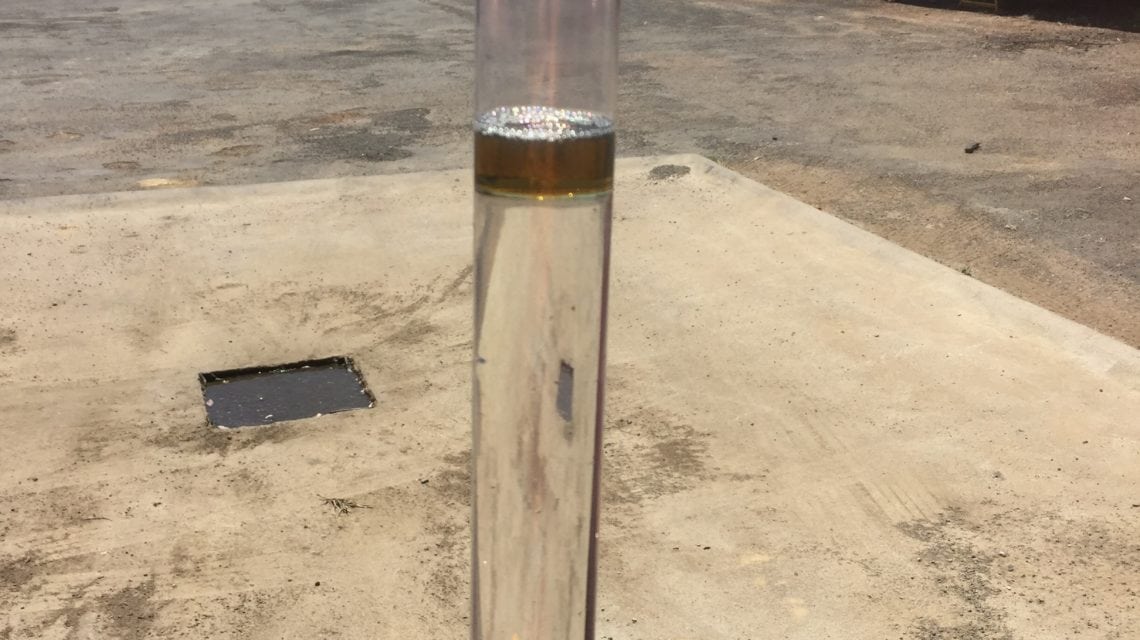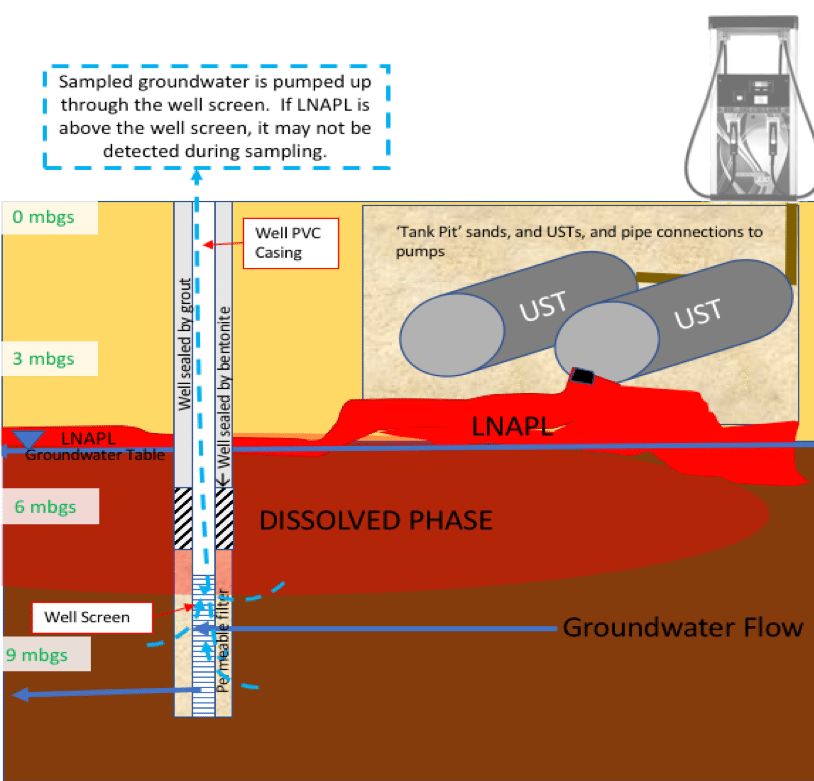Light nonaqueous phase liquids (LNAPL), sometimes referred to as phase separated hydrocarbons (PSH), are hydrocarbons that have densities lower than water and don’t mix with water (i.e. think of petrol or oil floating on water). In environmental consulting, we generally come across LNAPL when it floats on the groundwater table or is sorbed into the soil around and above the water table from the source it had leaked from (i.e. underground storage tanks (USTs), pipes etc), and are often engaged to assess and remediate it.
Most LNAPL contamination comes from hydrocarbon (usually petroleum or diesel) product that has leaked from underground petroleum storage tanks, pipes and fittings.
Since LNAPL’s density is less than water, LNAPL tends to float near the top of the water table, and it can continue to spread as the water table rises and falls and smears LNAPL through the subsurface. Over time the LNAPL weathers and dissolves into groundwater. This results in a spreading dissolved phase plume.
LNAPL can be a serious risk to both humans and the environment. Groundwater contaminated with LNAPL can seep into adjacent basements, or escape into surface water bodies such as creeks, and is a potentially long term source of ongoing groundwater contamination and volatile hydrocarbon vapours. LNAPL can continue to spread when contaminated groundwater is extracted for use elsewhere, and the process of extraction, as affecting neighbouring properties and causing risk when neighbouring properties are redeveloped or have basements. Vapour intrusion, where volatile chemicals rise out of contaminated groundwater or soil into the air within closed environmental (such as basements or buildings), can also be an explosive risk and/or human health risk. This is a common concern with LNAPL hydrocarbon plumes.
All LNAPL spills and leaks should be investigated and reported immediately to the relevant EPA body, who will advise whether further notifications need to be made depending on the size of the LNAPL release. A risk assessment must then be conducted to determine how best to manage the LNAPL. While LNAPL can’t be completely removed, it should be remediated to levels where it is no longer spreading and further active remediation would not be required lower the risks of remaining levels of LNAPL. Often when the risk has been controlled through active remediation, the site remediation will enter into monitored natural attenuation at suitable sites, where groundwater samples (and other samples) are collected to measure the contamination plume, and also measure chemicals and groundwater quality parameters that indicate natural processes including weathering and biological decompoistion continue to naturally and passively decrease contamination levels in the subsurface.
Substantial environmental liability is often associated with underground storage tanks (current and historic). When purchasing (or selling) a property, doing a thorough environmental due diligence is imperative (many times we have seen contamination caused by LNAPL and petroleum causing enough liability to cause a property to be a zero dollar or negative value asset).
LNAPL can be detected in monitoring wells, however the wells need to have been constructed appropriately, screened across the top of the water table. LNAPL will only be detected by wells that are screened across the top of the water table.
If LNAPL is present, wells can also be used to treat or extract groundwater. Don’t be fooled by groundwater monitoring wells that have water levels above the screened interval, as they often miss the LNAPL providing false information on contamination (see diagram above). If groundwater is extracted, eventually it will show signs that dissolved contaminant concentrations are decreasing (as fresh groundwater is drawn into the pumps), however, groundwater often shows ‘rebound’, when groundwater stabilises and over time LNAPL sorbed to soil recontaminates the groundwater. Imagine having an environmental report that shows the site has been remediated and is suitable for a use based on environmental risk, and the new purchaser later conducts groundwater monitoring and finds LNAPL! It may make retirement unpleasant after selling your business or site (and retaining legal liability!).
If you do have LNAPL contamination, there are strategic ways to balance remediation and human health and environmental risk, and also utilise naturally occurring bacteria to help digest carbon from the hydrocarbons.
iEnvi have dozens of years in assessment petroleum and underground storage tank contamination, including running national petroleum assessment and remediation programs in Australia and internationally to helping individuals sell their property, and helping local governments with their depots and manage environmental risk. If you are a Council, Property Owner or Business and would like advice how to strategically assess and manage LNAPL contamination, contact us on [email protected] or 13000 43684 (13000 iEnvi).



